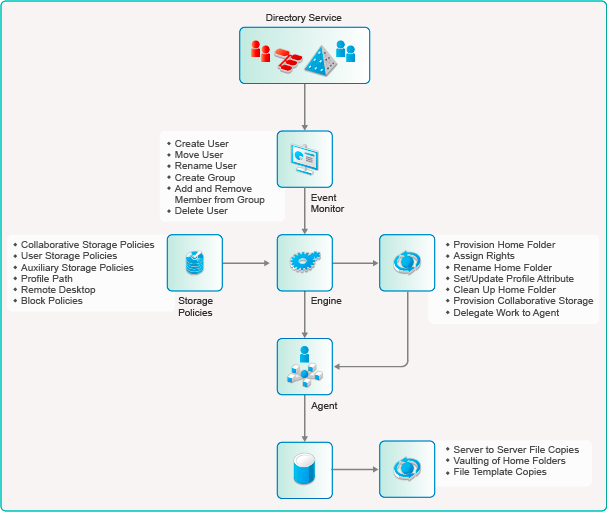2.0 Overview
Micro Focus Storage Manager introduces management and structure to an unmanaged and unstructured network storage system. In the process, it automates the full life cycle management of user and group storage. Leveraging directory services (commonly referred to as “the directory”), Storage Manager automates a comprehensive set of storage management tasks based on events, identity, and policies.
The Directory
Microsoft Active Directory stores the identity information about the users and groups that Storage Manager manages. When Storage Manager is installed, it adds or modifies user and group attributes so that they can be managed through Storage Manager.
Events
When a user in Active Directory is added, moved, renamed, or deleted, it is known as a directory “event.”
Policies
Policies within Storage Manager indicate what storage-specific actions to enact when an event in Active Directory takes place. These actions include creating user or collaborative storage when a new user is added to Active Directory, moving storage when a user is moved from one organizational unit or group to another, and archiving or deleting storage when a user is removed.
Storage Manager lets you create the following types of policies:
User Home Folder: Manages home folders for users who access their storage from an assigned user workstation.
User Profile Path: Used for profile path management
User Remote Desktop Services Home Folder: Used for users who get network access from remote client machines. Prior to Windows Server 2008, these were referred to as Terminal Services Home Folders.
User Remote Desktop Services Profile Path: Used for profile path management for users who get network access from remote client machines. Prior to Windows Server 2008, these were referred to as Terminal Services Profile Paths.
Container: Manages the users located in an organizational unit.
Group: Manages the users that are members of a group.
Auxiliary: Manages one or more additional storage locations in association with one of the four user policy types.
Multi-Principal Group Storage: Allows for multiple groups to access a shared group folder, with each group having different sets of permissions to the group folder.
Management Actions
In managing user and collaborative storage with Storage Manager, there are cases when you need to retroactively apply policies, rights, attributes, and quotas to existing user storage, or perform some administrative corrective action or operation on a large set of users, groups, or containers.
In Storage Manager, performing these types of operations is collectively referred to as performing a Management Action and is done through the Take Action page.
You can perform a Management Action on an organizational unit, a Group object, or a User object. Management Action operations on a Group object apply to users who are members of the group. Management Action operations on an organizational unit apply to users in the organizational unit, and optionally to all subordinate organizational units.
Operations
Despite Storage Manager’s ability to automate network file system management actions through policies or Management Actions, there are some cases where you will want to perform non-policy based management tasks. For example, suppose that in addition to Storage Manager, you also had Micro Focus File Reporter and through a Date-Age report, you determined that you had some department shares storing files that had not been accessed for five years or more.
Through a Groom operation, you could move these files to a less expensive secondary storage location, without having to first create a policy associated to the department shares.
Engine
The Engine performs actions based on events in Active Directory and the defined Storage Manager policies. These actions include provisioning, moving, grooming, deleting, renaming, and vaulting in the file system. There is only a single Engine per forest and it can be installed on a domain controller or a member server. The Engine runs as a native NT service on Windows.
Event Monitor
The Event Monitor monitors changes to Active Directory based on create, move, rename, delete, add member to group, and delete user from group events. You install one Event Monitor per domain, and it can run on a domain controller or a member server. If you install the Event Monitor on a domain controller, the Event Monitor always monitors the local server for changes in the domain. If the Event Monitor is installed on a member server, it identifies the closest available domain controller and monitors it for changes in the domain. The Event Monitor runs as a native NT service on Windows.
Agents
Agents perform copying, moving, grooming, deleting, and vaulting through directives from the Engine. For optimum performance, Agents should be installed on all servers with storage managed by Storage Manager. The Agent runs as a NT native service on Windows.
